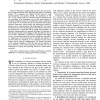Free Online Productivity Tools
i2Speak
i2Symbol
i2OCR
iTex2Img
iWeb2Print
iWeb2Shot
i2Type
iPdf2Split
iPdf2Merge
i2Bopomofo
i2Arabic
i2Style
i2Image
i2PDF
iLatex2Rtf
Sci2ools
TWC
2010
2010
On the Efficacy of Frequency Hopping in Coping with Jamming Attacks in 802.11 Networks
Abstract--Frequency hopping (FH) has been the most popularly considered approach for alleviating the effects of jamming attacks. We re-examine, the efficacy of FH based on both experimentation and analysis. Briefly, the limitations of FH are: (a) the energy spill over between adjacent channels that are considered to be orthogonal, and (b) the small number of available orthogonal bands. In a nutshell, the main contributions of our work are: (a) Construction of a measurement-driven game theoretic framework which models the interactions between a jammer and a communication link employing FH. Our model accounts for the above limiting factors and provides bounds on the performance of proactive FH in coping with jamming. (b) Extensive experimentation to quantify the impact of a jammer on 802.11a/g/n networks. Interestingly, we find that 802.11n devices can be more vulnerable to jamming as compared with legacy devices. We carefully analyze the reasons behind this observation. (c) Application ...
Artificial Intelligence | Available Orthogonal Bands | Current 802.11 Networks | Proactive Fh | TWC 2010 |
| Added | 23 May 2011 |
| Updated | 23 May 2011 |
| Type | Journal |
| Year | 2010 |
| Where | TWC |
| Authors | Konstantinos Pelechrinis, Christos Koufogiannakis, Srikanth V. Krishnamurthy |
Comments (0)

